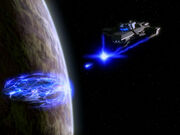Kingfisher (talk | contribs) No edit summary |
No edit summary |
||
| Line 16: | Line 16: | ||
The use of a [[cloaking device]] often leaves residual antiprotons that can expose the ship's presence. The [[Reman]] [[warbird]] ''[[Scimitar]]'' was equipped with an advanced cloaking device that left no such trace. ({{film|10}}) |
The use of a [[cloaking device]] often leaves residual antiprotons that can expose the ship's presence. The [[Reman]] [[warbird]] ''[[Scimitar]]'' was equipped with an advanced cloaking device that left no such trace. ({{film|10}}) |
||
| + | |||
| + | ==Real World Physics== |
||
| + | As noted above, the discovery of the Antiproton was a landmark achievement in modern physics. Like the [[positron]], the anti-matter anti-proton annihilates itself instantly upon coming in contact with a matter counterpart such as a proton. Antiprotons, should a flux ever be generated, would be highly corrosive to matter, generating lethal fluxes of high radiation as annihilation takes place. Such a flux generation is at present beyond current capabilities, though it is hope the forthcoming CERN super-collider may be able to produce brief fluxes of antimatter particles such as antiprotons. |
||
| + | |||
| + | Anti-proton detection and manipulation is confined at present to high-speed physics experiments, and they are detected exclusively in cloud chambers of particle accelerators. |
||
==See also== |
==See also== |
||
Revision as of 21:37, 10 February 2008

The Delta Rana warship firing a beam of jacketed antiprotons and positrons.
An antiproton is the antimatter counterpart of a proton. On Earth, the antiproton's existence was theorized in the 1930s, and the particle itself was discovered in 1955, a Nobel prize-winning achievement.
A beam of pure antiprotons is an incredibly destructive weapon. Such a weapon was used by the so-called "doomsday machine" to destroy planets. (TOS: "The Doomsday Machine")
The Delta Rana warship, created by the Douwd Kevin Uxbridge, used jacketed beams of antiprotons and positrons as its main weapon. It fired beams with a power of forty megawatts, and later four hundred gigawatts, at the USS Enterprise-D. (TNG: "The Survivors")
The Crystalline Entity left behind a trail of antiprotons, by which it can be tracked across space. (TNG: "Silicon Avatar")
Romulan disruptors leave a characteristic trace of residual antiprotons, which can be used to date when the weapon was fired. (TNG: "Face of the Enemy")
The deflector dish of Sovereign-class starships is charged with antiprotons. (Star Trek: First Contact)
The Jem'Hadar use antiproton beams to detect cloaked ships. (DS9: "The Search, Part I")
In 2372, the Doctor on the USS Voyager used bursts of antiprotons from the warp core to reverse the effects of hyper-evolution on Tom Paris and Kathryn Janeway, by destroying the mutated segments of DNA. (VOY: "Threshold")
The use of a cloaking device often leaves residual antiprotons that can expose the ship's presence. The Reman warbird Scimitar was equipped with an advanced cloaking device that left no such trace. (Star Trek Nemesis)
Real World Physics
As noted above, the discovery of the Antiproton was a landmark achievement in modern physics. Like the positron, the anti-matter anti-proton annihilates itself instantly upon coming in contact with a matter counterpart such as a proton. Antiprotons, should a flux ever be generated, would be highly corrosive to matter, generating lethal fluxes of high radiation as annihilation takes place. Such a flux generation is at present beyond current capabilities, though it is hope the forthcoming CERN super-collider may be able to produce brief fluxes of antimatter particles such as antiprotons.
Anti-proton detection and manipulation is confined at present to high-speed physics experiments, and they are detected exclusively in cloud chambers of particle accelerators.
See also
External links
- Antiproton at Wikipedia
